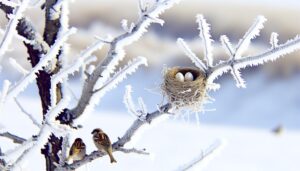10 Steps to Successfully Raise Baby Sparrows
Raising baby sparrows involves understanding strict legal and care requirements. Under the Migratory Bird Treaty Act, you must collaborate with licensed wildlife rehabilitators and local authorities.
Carefully observe chicks to confirm they're abandoned. You'll need a secure, temperature-controlled enclosure (32-35°C) and feed them a high-protein diet every 15-20 minutes from dawn to dusk.
Maintain rigorous hygiene to prevent infections and regularly monitor their health. Raising involves a long-term commitment to ensuring proper health, nutrition, and eventual release.
Continue if you want detailed guidance on each care step, from initial care to long-term commitment.

Key Takeaways
- Check local laws and regulations to ensure compliance with the Migratory Bird Treaty Act.
- Collaborate with licensed wildlife rehabilitators for legal and expert assistance.
- Provide a warm, secure enclosure with a temperature of 32-35°C.
- Feed a high-protein diet every 15-20 minutes from dawn to dusk.
- Maintain strict hygiene and monitor health regularly to prevent infections.
Legal Considerations

Before you decide to raise baby sparrows, understanding that many regions have specific legal protections for wild birds, including permits and regulations, is crucial.
The Migratory Bird Treaty Act, for instance, prohibits the possession of most native bird species without proper authorization. Violating these laws can lead to fines or other penalties. Contacting local wildlife authorities to determine the legal requirements in your area is necessary. Some jurisdictions may require you to collaborate with licensed wildlife rehabilitators.
Detailed observations indicate that these legal frameworks are in place to safeguard native populations and promote their well-being. By abiding by these regulations, you're contributing to conservation efforts and helping uphold ecological balance. Always prioritize the birds' best interests while following legal standards.
Finding Abandoned Chicks
Identifying truly abandoned chicks requires careful observation and an understanding of sparrow nesting behaviors. First, observe the nest from a distance for at least an hour, using binoculars if necessary. Adult sparrows typically return to feed their young every 10-15 minutes. If no adult activity is observed, approach the nest cautiously to check for signs of life.
Note the chicks' condition: healthy chicks will exhibit active movements and vocalization. If the chicks appear lethargic, cold, or unresponsive, they might be abandoned. Check for any visible injuries or parasites. Document these observations meticulously. Your intervention should be evidence-based, ensuring that human interference is necessary and beneficial. Remember, the goal is to act in the chicks' best interest.
Initial Care and Housing

To guarantee the survival of abandoned baby sparrows, you should first prepare a warm, secure enclosure that mimics their natural nesting environment. Choose a small, ventilated container lined with soft materials such as tissue or cloth to prevent injuries.
Maintain the ambient temperature at 32-35°C (90-95°F) using a heat lamp or heating pad, as thermoregulation is vital for the chicks' metabolic functions. Monitor the temperature with a reliable thermometer, ensuring it remains consistent.
Place the enclosure in a quiet, dimly lit area to reduce stress. Regularly clean the enclosure to prevent bacterial growth, using proper sanitation techniques. This initial care fosters a controlled environment, promoting the sparrows' physiological stability and enhancing their chances of survival.
Feeding Requirements
Feeding baby sparrows demands a high-protein diet that replicates the insects and invertebrates their parents would provide in the wild. You need to offer a mixture of soaked dog or cat kibble, hard-boiled eggs, and mealworms. Confirm the food is appropriately sized to prevent choking.
Feed them every 15-20 minutes from dawn to dusk, as their rapid growth demands frequent nourishment. Use tweezers or a small syringe to place the food directly into their mouths, mimicking parental feeding behavior.
Maintain meticulous records of feeding times and quantities to monitor their growth effectively. Proper nutrition supports their physiological development, ensuring they gain strength and feathers at the appropriate rate.
Your dedication can profoundly impact their survival and well-being.
Health and Hygiene

Maintaining peak health and hygiene for baby sparrows involves regular examination for parasites and prompt cleaning of their living environment to prevent infections. You should inspect the sparrows for mites and lice, common ectoparasites that can weaken their immune systems. Use a magnifying glass to check for small, moving specks on their feathers.
Clean their cage daily, replacing soiled bedding with fresh material. Disinfect feeding and watering containers with a bird-safe solution to eliminate bacteria and fungi. Guarantee proper ventilation in their habitat to reduce respiratory issues caused by mold or ammonia buildup from droppings.
Monitoring their droppings' color and consistency can also help in early detection of gastrointestinal problems. By following these steps, you'll promote healthier, thriving baby sparrows.
Socialization Needs
You'll need to guarantee baby sparrows receive adequate socialization to promote healthy development. Regular interaction with humans can enhance their adaptability and reduce stress responses.
Additionally, facilitating bonding with siblings fosters natural behaviors and strengthens social structures.
Interaction With Humans
Establishing regular, gentle interactions with baby sparrows is vital for their social development and helps prevent them from becoming overly fearful of humans. Consistent exposure to your presence can enhance their adaptability and reduce stress levels.
Scientific observations show that touch and vocal communication play important roles in fostering trust. Gently handling the sparrows and speaking softly to them can stimulate positive responses, evidenced by increased feeding efficiency and reduced anxiety behaviors.
Ensure interactions are brief but frequent, maintaining a calm environment. By doing so, you're aiding in their cognitive development, ultimately making them more resilient. Your dedication and patience in these early stages will have a significant impact on their ability to thrive under human care.
Bonding With Siblings
Just as consistent human interaction supports a baby sparrow's social development, fostering strong bonds with its siblings is equally vital for its overall well-being and growth.
Observational studies indicate that sibling interactions enhance cognitive development and stress resilience. When sparrows engage in mutual preening, feeding, and play, they develop essential social skills and establish a pecking order, reducing future conflicts.
Data shows that isolated chicks exhibit higher stress levels and slower growth rates. To facilitate sibling bonding, make sure the nest area is spacious and enriching, with opportunities for interactive activities.
Preparing for Release

Guiding your baby sparrows from captivity to the wild requires ensuring they are fully capable of foraging independently and recognizing potential threats.
Begin with a gradual acclimatization process. Place their enclosure outside to expose them to natural weather conditions and diurnal cycles. Monitor their behavior closely to ensure they are skilled at locating food and water.
Evidence shows sparrows learn essential skills through observation and practice; therefore, provide opportunities for them to mimic wild behaviors. Introduce predator cues, like recorded sounds, to enhance their threat recognition.
Once they display consistent self-sufficiency, choose a release site with abundant food sources and cover. Your attentive preparation increases their survival odds, fostering successful reintegration into their natural habitat.
Long-Term Commitment
Caring for baby sparrows demands a significant time investment, requiring meticulous daily attention to their nutritional and environmental needs.
You'll observe that their growth and survival hinge on consistent care, particularly during the early stages.
Evidence indicates that sparrows can live up to 3-5 years in captivity, necessitating a long-term commitment to their well-being.
Time Investment Required
Raising baby sparrows demands a significant long-term commitment, requiring daily feedings, regular health checks, and consistent environmental maintenance to guarantee their proper development.
Observational studies show that sparrow fledglings need food every 20-30 minutes from dawn until dusk, translating to a substantial time investment.
Health assessments should be performed daily to monitor for signs of illness, such as changes in plumage or lethargy.
Environmental upkeep includes maintaining an appropriate temperature and humidity level, essential for their delicate physiology.
Evidence indicates that sparrows raised in stable conditions exhibit higher survival rates and improved overall health.
Your dedication to these tasks ensures the sparrows thrive, embodying your commitment to serve and nurture these vulnerable creatures.
Daily Care Needs
Given the significant time investment required, daily care needs for baby sparrows involve meticulous feeding schedules, rigorous health monitoring, and strict environmental controls to secure their peak growth and survival.
You'll need to feed them every 2-3 hours with a specialized diet rich in proteins and vitamins. Careful observation of their droppings can provide insights into their digestive health, while weighing them daily guarantees appropriate growth rates.
Maintaining a clean, temperature-controlled environment, ideally around 32-35°C (89.6-95°F), is essential. Regularly disinfect feeding tools and nesting areas to prevent infections.
Lifespan and Longevity
Understanding the lifespan and longevity of baby sparrows requires recognizing that these birds can live up to 3-5 years in the wild, with some individuals reaching even longer lifespans under ideal conditions. When raising baby sparrows, you must prepare for a long-term commitment. Ensuring proper nutrition, habitat, and healthcare plays an optimal role in extending their lifespan.
| Environment | Impact on Lifespan |
|---|---|
| Wild | 3-5 years |
| Captivity | Potentially longer |
| Poor Nutrition | Shortened lifespan |
| Best Care | Extended longevity |
Conclusion
Raising baby sparrows is a rewarding yet complex endeavor, requiring adherence to legal regulations and meticulous care.
You'll need to provide proper housing, nutrition, and socialization—think of it as building a tiny bird utopia.
Your observational skills and evidence-based strategies will be essential for their survival and eventual release.
Remember, it's like nurturing a Tamagotchi, but in real life.
If you commit, these fledglings can thrive under your watchful eye and dedicated care.






